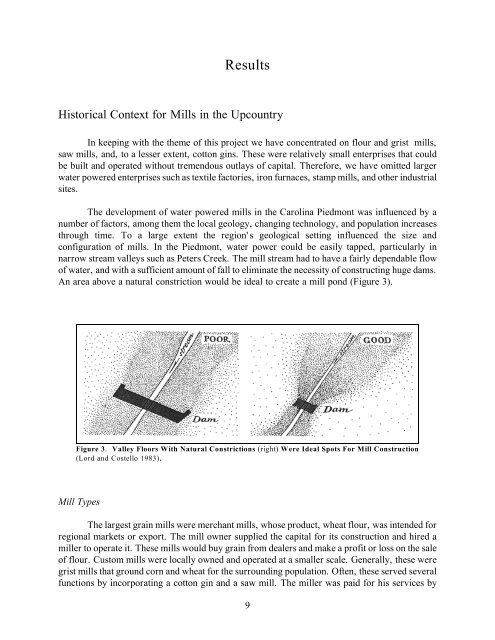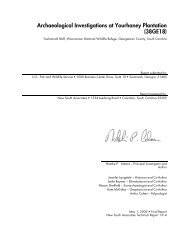Mills in the Upcountry: a Historic Context, and a Summary of a Mill ...
Mills in the Upcountry: a Historic Context, and a Summary of a Mill ...
Mills in the Upcountry: a Historic Context, and a Summary of a Mill ...
You also want an ePaper? Increase the reach of your titles
YUMPU automatically turns print PDFs into web optimized ePapers that Google loves.
Results<br />
<strong>Historic</strong>al <strong>Context</strong> for <strong><strong>Mill</strong>s</strong> <strong>in</strong> <strong>the</strong> <strong>Upcountry</strong><br />
In keep<strong>in</strong>g with <strong>the</strong> <strong>the</strong>me <strong>of</strong> this project we have concentrated on flour <strong>and</strong> grist mills,<br />
saw mills, <strong>and</strong>, to a lesser extent, cotton g<strong>in</strong>s. These were relatively small enterprises that could<br />
be built <strong>and</strong> operated without tremendous outlays <strong>of</strong> capital. Therefore, we have omitted larger<br />
water powered enterprises such as textile factories, iron furnaces, stamp mills, <strong>and</strong> o<strong>the</strong>r <strong>in</strong>dustrial<br />
sites.<br />
The development <strong>of</strong> water powered mills <strong>in</strong> <strong>the</strong> Carol<strong>in</strong>a Piedmont was <strong>in</strong>fluenced by a<br />
number <strong>of</strong> factors, among <strong>the</strong>m <strong>the</strong> local geology, chang<strong>in</strong>g technology, <strong>and</strong> population <strong>in</strong>creases<br />
through time. To a large extent <strong>the</strong> region' s geological sett<strong>in</strong>g <strong>in</strong>fluenced <strong>the</strong> size <strong>and</strong><br />
configuration <strong>of</strong> mills. In <strong>the</strong> Piedmont, water power could be easily tapped, particularly <strong>in</strong><br />
narrow stream valleys such as Peters Creek. The mill stream had to have a fairly dependable flow<br />
<strong>of</strong> water, <strong>and</strong> with a sufficient amount <strong>of</strong> fall to elim<strong>in</strong>ate <strong>the</strong> necessity <strong>of</strong> construct<strong>in</strong>g huge dams.<br />
An area above a natural constriction would be ideal to create a mill pond (Figure 3).<br />
Figure 3. Valley Floors With Natural Constrictions (right) Were Ideal Spots For <strong>Mill</strong> Construction<br />
(Lord <strong>and</strong> Costello 1983).<br />
<strong>Mill</strong> Types<br />
The largest gra<strong>in</strong> mills were merchant mills, whose product, wheat flour, was <strong>in</strong>tended for<br />
regional markets or export. The mill owner supplied <strong>the</strong> capital for its construction <strong>and</strong> hired a<br />
miller to operate it. These mills would buy gra<strong>in</strong> from dealers <strong>and</strong> make a pr<strong>of</strong>it or loss on <strong>the</strong> sale<br />
<strong>of</strong> flour. Custom mills were locally owned <strong>and</strong> operated at a smaller scale. Generally, <strong>the</strong>se were<br />
grist mills that ground corn <strong>and</strong> wheat for <strong>the</strong> surround<strong>in</strong>g population. Often, <strong>the</strong>se served several<br />
functions by <strong>in</strong>corporat<strong>in</strong>g a cotton g<strong>in</strong> <strong>and</strong> a saw mill. The miller was paid for his services by<br />
9







